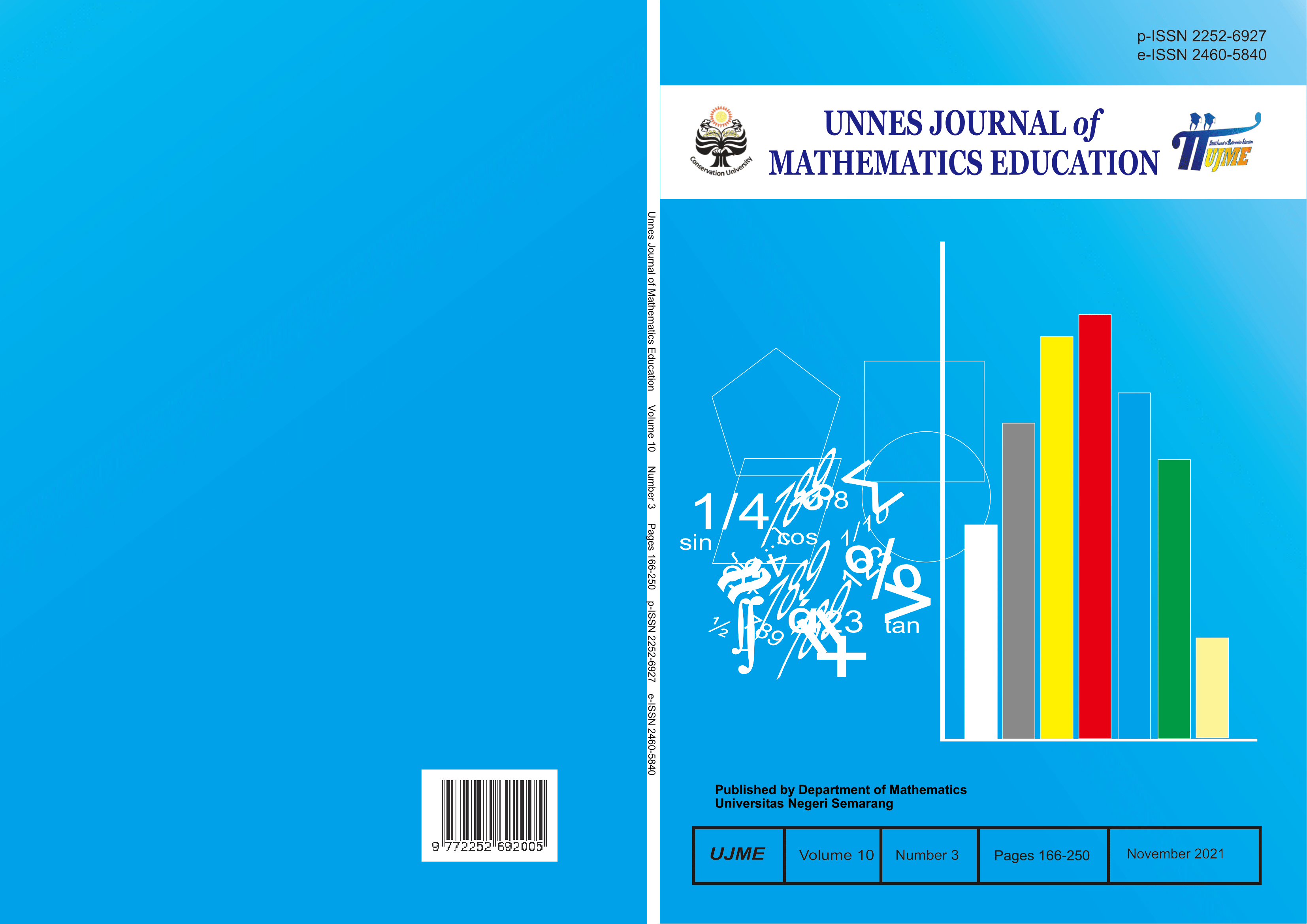The Development of Science, Technology, Engineering, Arts and Mathematics Nuanced Mathematics Teaching Materials to Improve Mathematical Conceptual Understanding Ability
##plugins.themes.academic_pro.article.main##
Abstract
This research is a development research that aims to develop mathematics teaching materials related to Science, Technology, Engineering, Arts, and Mathematics (STEAM). This study uses the stages of Research and Development (R&D) covering potential and problems; data collection; product design; design validation (potential test and feasibility test); product test (readability test and attractiveness test); use trials (effectiveness test) and the final product. The results of the study indicate that teaching materials have the potential to improve the ability of mathematical conceptual understanding; valid, easy to understand, attractive in appearance, and effectively improve the ability of mathematical conceptual understanding. The test results show that teaching materials have the potential to increase the ability of mathematical conceptual understanding with a percentage of 86.5%. The results of the feasibility test show that the teaching materials are valid for use with a percentage of 86.07%. The results of the readability test showed that the teaching materials were easily understood by students with a percentage of 92.26%. The results of the response test showed that the teaching materials were attractive in appearance with a percentage of 90.15%. Then, the results of the effectiveness test showed that the teaching materials were effective in increasing the ability of mathematical conceptual understanding.
##plugins.themes.academic_pro.article.details##
References
Arafah, S. F., S. Ridhlo, & B. Priyono. (2012). Pengembangan LKS Berbasis Berpikir Kritis pada Materi Animalia. Unnes Journal of Biology Education, 1(1): 47-53.
Arvyaty, Salim, &. Maryanti. E. (2018). Design of Teaching Material Literacy Mathematical Nuanced in Junior High School Students. Journal of Physics: Conference Series, 1028(1).
BSNP. (2015). Pedoman Penilaian Buku Teks Matematika. Jakarta: Ristekdikti.
Buinicontro, J.K. (2018). Gathering STE(A)M: Policy, Curricular, And Programmatic Developments In Arts-Based Science, Technology, Engeneering, And Mathematics Education Introduction To Special Issue Of Art Education Policy Review: STEAM Focus. Art Education Policy Review Journal, 119-Issue 2.
Dobres, J., Chahine, N., & Reimer, B. (2017). Effects of ambient illumination, contrast polarity, and letter size on text legibility under glance-like reading. Applied Ergonomics, 60, 68-73.
Fajar, A. P., Kodirun, Suhar & Arapu, L. (2018). Analisis Kemampuan Pemahaman Konsep Matematis Siswa Kelas VIII SMP Negeri 17 Kendari. Jurnal Pendidikan Matematika, 9(2), 229-239.
Haryanti, F., & Saputro, B. A. (2016). Pengembangan Modul Matematika Berbasis Discovery Learning Berbantuan FlipBook Maker Untuk Meningkatkan Kemampuan Pemahaman Konsep Siswa Pada Materi Segitiga. Kalamatika: Jurnal Pendidikan Matematika, 1(2), 147-161.
Hasanah, H., Wirawati, S. M., & Sari, F. A. (2020). Pengembangan Bahan Ajar Matematika Berbasis STEM Pada Materi Bangun Ruang. Indonesian Journal of Learning Education and Counseling, 3(1), 91-100.
Lestari, I. (2018). Pengembangan Bahan Ajar Matematika Dengan Memanfaatkan Geogebra Untuk Meningkatkan Pemahaman Konsep. GAUSS: Jurnal Pendidikan Matematika, 1(1), 26-36.
Nugraha, D. A., & Binadja, A. (2013). Pengembangan bahan ajar reaksi redoks bervisi SETS, berorientasi konstruktivistik. Journal of Innovative Science Education, 2(1), 27-34.
Nurhikmayati, I. (2019). Implementasi STEAM dalam Pembelajaran Matematika. Didactical Mathematics, 1(2), 41-50.
Nurichah, E. F. (2012). Pengembangan Lembar Kegiatan Siswa Berbasis Keterampilan Berpikir Kritis pada Materi Keanekaragaman Hayati. BioEdu, 1(2), 45-49.
Oktaviani, W., Gunawan, G., & Sutrio, S. (2017). Pengembangan Bahan Ajar Fisika Kontekstual Untuk Meningkatkan Penguasaan Konsep Siswa. Jurnal Pendidikan Fisika dan Teknologi, 3(1), 1-7.
Pangesti, K. I., Yulianti, D., & Sugianto, S. (2017). Bahan Ajar Berbasis STEM (Science, Technology, Engineering, and Mathematics) untuk Meningkatkan Penguasaan Konsep Siswa SMA. UPEJ Unnes Physics Education Journal, 6(3), 53-58.
Sugiyono. (2017). Metode Penelitian Pendidikan. Bandung: Alfabeta.
Suraji, S., Maimunah, M., & Saragih, S. (2018). Analisis kemampuan pemahaman konsep matematis dan kemampuan pemecahan masalah matematis siswa smp pada materi sistem persamaan linear dua variabel (SPLDV). Suska Journal of Mathematics Education, 4(1), 9-16.
Utami, T.N., Jatmiko, A., & Suherman, S. (2018). Pengembangan Modul Matematika dengan Pendekatan Science, Technology, Engineering, And Mathematics (STEM) pada Materi Segiempat. Desimal: Jurnal Matematika, 1(2), 165-172.
Zubaidah, S. (2019, September). STEAM (science, technology, engineering, arts, and mathematics): Pembelajaran untuk memberdayakan keterampilan abad ke-21. In Seminar Nasional Matematika Dan Sains, September (pp. 1-18).
